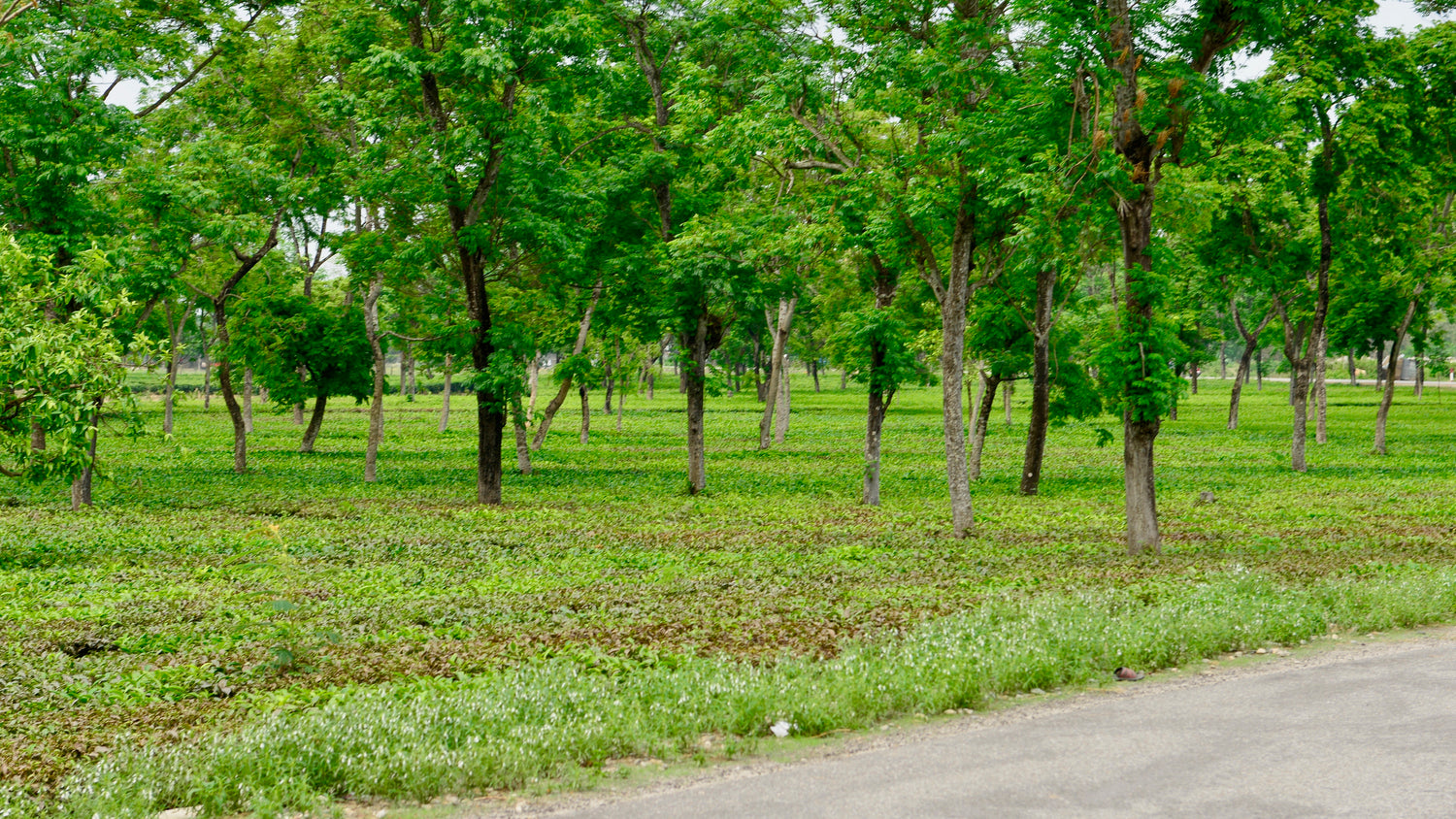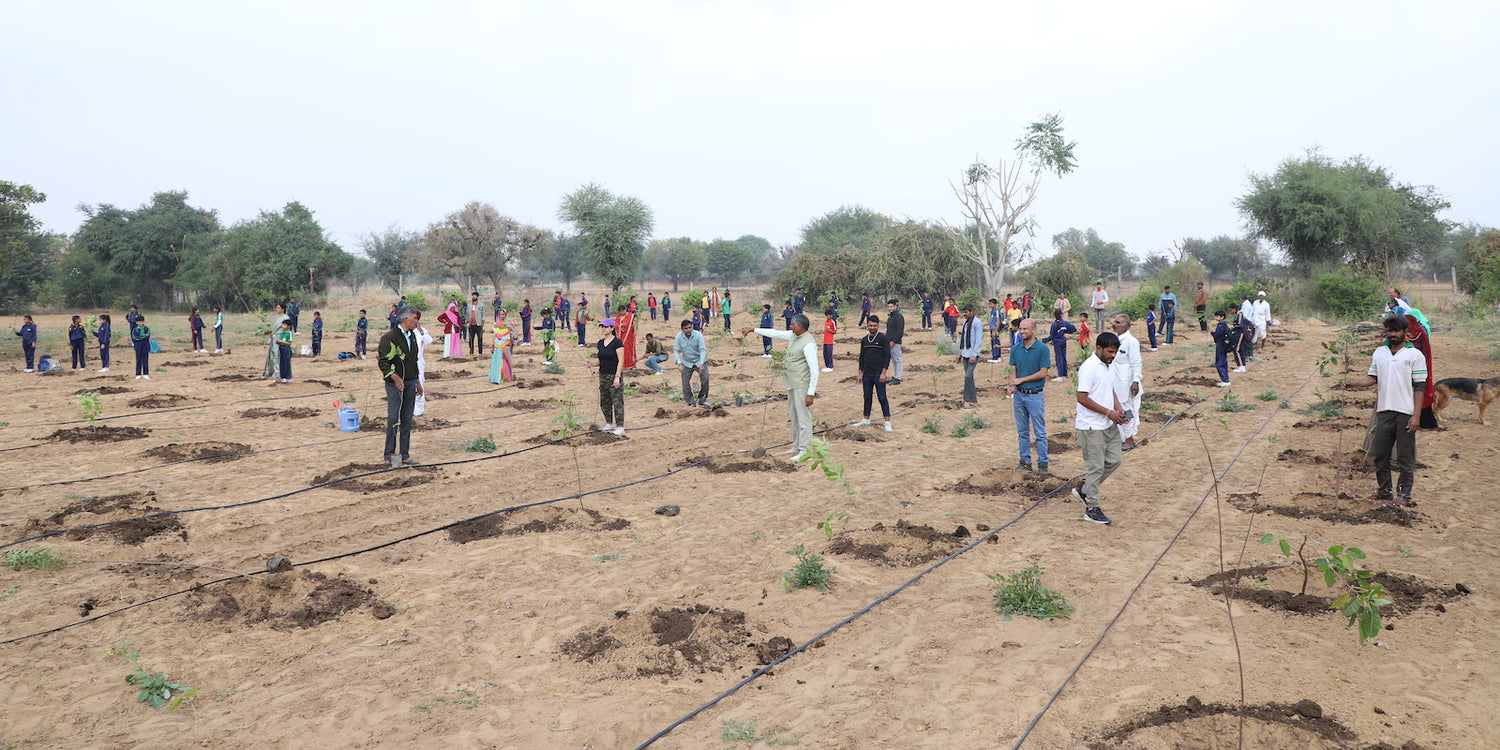Agroforestry in Andhra Pradesh: Blending Agriculture and Forestry for
Andhra Pradesh, with its diverse landscapes spanning coastal plains, hills, and semi-arid zones, has immense potential to embrace agroforestry as a su Read more
Connect with us
-
👥 Corporates
If you are looking for:
- 🌲 Tree Plantation Events
- 📊 CSR Projects
📧 corporate@growbilliontrees.com
📞 +91 9699723523
💬 +91 9325931304 WhatsApp (Only)
🕒 Mon - Sat | 10am - 7pm IST
-
🧩 Tree Plantation NGOs
If you are looking for:
- 💰 Financial Assistance
- 🤝 Operational Support
📧 support@growbilliontrees.com
📞 +91 9699723523
💬 +91 9325931304 WhatsApp (Only)
🕒 Mon - Sat | 10am - 7pm IST
-
🌼 Individuals
If you are looking for:
- 👥 Group Tree Plantation Drive
- 🌳 Bulk Tree Plantation
📞 +91 9699723523
💬 +91 9325931304 WhatsApp (Only)
🕒 Mon - Sat | 10am - 7pm IST
Trending
Trees for Corporates
Agroforestry in Andhra Pradesh: Blending Agriculture and Forestry for Growth
Andhra Pradesh, with its diverse landscapes spanning coastal plains, hills, and semi-arid zones, has immense potential to embrace agroforestry as a sustainable land management system.
Combining trees, crops, and livestock, agroforestry enhances productivity, restores ecosystems, and provides a steady income for farmers. As the state grapples with challenges like soil degradation, water scarcity, and deforestation, agroforestry emerges as a promising solution.
This article explores agroforestry in Andhra Pradesh, its historical context, scientific benefits, and environmental impact while highlighting how Grow Billion Trees partners with local communities to promote and execute agroforestry projects across the state.
Historical Context of Agroforestry in Andhra Pradesh
Historically, Andhra Pradesh has had a deep connection with trees and agriculture. Traditional farming systems incorporated trees like Neem (Azadirachta indica), Tamarind (Tamarindus indica), and Mango (Mangifera indica), providing shade, fodder, and additional income.
Tribal communities in the Eastern Ghats practiced shifting cultivation and agroforestry, integrating fruit trees, medicinal plants, and food crops.
Coastal communities, especially in the Godavari and Krishna deltas, relied on mangroves for protection against cyclones while engaging in rice farming.
However, with the advent of monoculture and increasing pressure on land, tree-based farming systems declined. Today, agroforestry is being revitalized to address modern challenges like climate change, soil erosion, and farmer distress.
The Need for Agroforestry in Andhra Pradesh
1. Soil Health Restoration
Andhra Pradesh faces severe soil erosion and degradation, particularly in the Rayalaseema region. Agroforestry enhances soil fertility by improving organic matter and preventing erosion.
2. Climate Resilience
The state frequently experiences droughts, floods, and cyclones, especially in coastal areas. Agroforestry creates climate-resilient systems, buffering crops from extreme weather conditions.
3. Diversifying Farmer Incomes
With small landholdings and low crop diversification, farmers in Andhra Pradesh struggle with income variability. Agroforestry provides additional revenue through fruits, timber, and non-timber forest products.
4. Combating Water Scarcity
Regions like Anantapur and Kurnool face groundwater depletion. Agroforestry enhances groundwater recharge and reduces water runoff.
5. Supporting Biodiversity
Andhra Pradesh’s Eastern Ghats and coastal regions are rich in biodiversity. Agroforestry fosters ecosystems by creating habitats for wildlife, birds, and pollinators.
Scientific Benefits of Agroforestry
- Improving Soil Fertility: Trees like Subabul and Neem enrich soils with nitrogen, organic matter, and microbes, increasing crop productivity by 20–30%.
- Carbon Sequestration: Agroforestry systems sequester up to 25 tons of carbon dioxide per hectare annually, combating global warming.
- Water Conservation: Tree roots improve water retention, recharge groundwater, and reduce surface runoff, crucial for Andhra Pradesh’s drylands.
Common Agroforestry Systems in Andhra Pradesh
1. Silvo-Pastoral Systems
This system integrates trees and grasses to provide fodder for livestock while stabilizing degraded lands in regions like Rayalaseema.
2. Horti-Silviculture
Fruit trees like Mango, Guava, and Tamarind are combined with timber species like Teak to ensure year-round income and food security.
3. Mangrove-Based Agroforestry
In coastal areas, mangroves protect rice fields from cyclones while providing additional resources like honey and fish habitats.
4. Agri-Silviculture Systems
Crops like groundnut, millets, and pulses are grown alongside Eucalyptus or Casuarina, providing short-term and long-term income.
Fun Facts About Agroforestry in Andhra Pradesh
- Mango Paradise: Andhra Pradesh is India’s largest producer of mangoes, and agroforestry systems amplify its production while maintaining soil health.
- Timber Gold: Fast-growing species like Eucalyptus and Subabul thrive in agroforestry systems, offering timber for construction and paper industries.
- Mangrove Marvels: Mangroves in the Krishna and Godavari deltas are vital for protecting agriculture and marine ecosystems from cyclones.
Environmental Impact of Agroforestry in Andhra Pradesh
1. Cyclone Mitigation
Mangrove agroforestry in coastal areas reduces the impact of cyclones by acting as a natural buffer against tidal surges.
2. Combating Soil Erosion
Tree roots stabilize soil, preventing erosion in upland and deltaic regions. This is especially important in drought-prone Anantapur.
3. Flood Prevention
Agroforestry systems improve water infiltration, reducing runoff and flood risks in low-lying delta regions of the Godavari basin.
4. Promoting Biodiversity
Tree-based farming systems provide habitats for local flora and fauna, fostering biodiversity in agroforestry landscapes.
Challenges in Adopting Agroforestry
-
Lack of Awareness
Many farmers in Andhra Pradesh are unaware of agroforestry’s benefits, leading to slow adoption rates. -
Water Scarcity
Regions with erratic rainfall face challenges in sustaining agroforestry systems without irrigation support. -
Market Barriers
Farmers struggle with market access for timber and non-timber products, reducing profitability. -
Policy Constraints
Regulations around tree felling and timber trade discourage farmers from planting high-value trees like Teak and Eucalyptus.
Grow Billion Trees: Revolutionizing Agroforestry in Andhra Pradesh
Grow Billion Trees is playing a pivotal role in transforming Andhra Pradesh’s agricultural and ecological landscape through agroforestry.
Collaborations
- Partnering with the Andhra Pradesh Forest Department, local NGOs, and farmer cooperatives to execute large-scale agroforestry projects.
- Collaborating with agricultural universities to develop innovative agroforestry models tailored to coastal and drought-prone areas.
Execution Strategies
- Tree Nurseries: Establishing nurseries to supply high-quality saplings of species like Mango, Subabul, Casuarina, and Eucalyptus.
- Farmer Training: Conducting workshops and field demonstrations to educate farmers on implementing and managing agroforestry systems.
- Coastal Restoration Projects: Promoting mangrove agroforestry in cyclone-prone areas to protect farmlands and strengthen ecosystems.
- Market Support: Creating market linkages for timber, fruits, and non-timber forest products to ensure fair pricing and steady demand.
Key Achievements by Grow Billion Trees
- Tree Plantation Drives: Over 5 million trees planted across Andhra Pradesh, improving green cover and restoring degraded lands.
- Farmer Empowerment: Trained over 10,000 farmers to adopt agroforestry, increasing their incomes by up to 40%.
- Carbon Sequestration: Agroforestry systems implemented by Grow Billion Trees have sequestered over 800,000 tons of carbon dioxide.
- Cyclone Resilience: Promoted mangrove and Casuarina plantations, protecting coastal farmlands from cyclonic destruction.
Future Prospects for Agroforestry in Andhra Pradesh
By 2030, agroforestry in Andhra Pradesh has the potential to:
- Increase the state’s green cover by 15–20%, contributing to India’s climate goals.
- Restore over 1 million hectares of degraded land, enhancing agricultural productivity.
- Support over 30,000 farming households, ensuring diversified and sustainable incomes.
- Protect 2,000 kilometers of coastal areas with mangrove and Casuarina agroforestry systems.
Conclusion
Agroforestry in Andhra Pradesh is much more than a farming practice; it is a transformative solution to the state’s ecological, agricultural, and economic challenges.
By blending trees with crops and livestock, agroforestry restores soil fertility, combats climate extremes, and creates sustainable livelihoods for farmers.
Grow Billion Trees is leading the agroforestry revolution in Andhra Pradesh by empowering farmers, restoring degraded lands, and fostering resilience in coastal and drought-prone regions.
Together, with collective efforts and innovations, agroforestry can pave the way for a greener, more productive, and sustainable future for Andhra Pradesh’s farmers and ecosystems.
Mango Agroforestry in Andhra Pradesh
Andhra Pradesh, the mango capital, integrates Mango trees into farms for sweet profits. These fruit-laden beauties enhance incomes while enriching soil fertility and improving biodiversity.
Casuarina Agroforestry in Andhra Pradesh
Casuarina trees are the coastal guardians, protecting fields from wind and cyclones while providing timber, fuelwood, and erosion control for farmers in Andhra Pradesh’s vulnerable coastal zones.
Neem in Andhra Pradesh Agroforestry
Neem trees work double duty by repelling pests, boosting soil health, and offering medicinal properties. It’s the eco-friendly hero every Andhra farmer needs in their agroforestry mix.
Horti-Silviculture Systems in Andhra Pradesh
Fruit trees like guava, tamarind, and jackfruit mingle with timber species, offering sustainable incomes, nutrition, and resilience in Andhra Pradesh’s mixed farming landscapes.
Bamboo Agroforestry in Andhra Pradesh
Bamboo grows faster than your weekend plans and supports construction, crafts, and livelihoods. In Andhra’s agroforestry systems, it’s a cash crop with green sustainability.
Silvo-Pastoral Systems in Andhra Pradesh
Combining trees and grasses creates fodder for livestock while preventing soil erosion in drought-prone Rayalaseema. It’s the ultimate agroforestry win-win for Andhra’s farmers.
Mangrove Agroforestry in Coastal Andhra Pradesh
Mangroves in the Krishna and Godavari deltas protect farms from storms, saltwater intrusion, and erosion, all while supporting marine biodiversity and sustainable fishing.
Eucalyptus in Andhra Agroforestry
Eucalyptus trees grow tall and fast, offering timber and pulp for industries. They’re a farmer’s choice in Andhra’s agri-silviculture systems for quick returns and resilience.
Agroforestry for Soil Health in Andhra Pradesh
Trees improve soil structure, prevent erosion, and restore nutrient balance, making Andhra’s lands fertile and productive for the long haul.
Agroforestry for Water Conservation in Andhra Pradesh
Tree roots reduce runoff, recharge groundwater, and stabilize water availability, tackling Andhra Pradesh’s water woes and helping crops thrive.
Jackfruit Agroforestry in Andhra Pradesh
Jackfruit, the hardy fruit tree, provides nutritious yields, fodder, and shade, making it a delicious and profitable agroforestry solution for Andhra Pradesh farmers.
Grow Billion Trees in Andhra Agroforestry
Grow Billion Trees transforms farmlands with saplings, farmer training, and market access, ensuring agroforestry becomes a sustainable growth engine for Andhra Pradesh’s future.
You may like
Corporate Plantations
FAQ
What is agroforestry in Andhra Pradesh?
Agroforestry combines trees with crops and livestock, boosting farm productivity and resilience. Grow Billion Trees promotes this practice to enhance Andhra Pradesh’s agriculture and environment.
Why is agroforestry important in Andhra Pradesh?
It combats soil erosion, diversifies incomes, and buffers against climate challenges. Grow Billion Trees supports farmers by introducing sustainable agroforestry systems across the state.
How do Casuarina trees benefit Andhra Pradesh’s farmers?
Casuarina trees protect coastal farms from cyclones, control soil erosion, and provide timber. Grow Billion Trees encourages their use for coastal resilience and farmer profitability.
What role do mangroves play in Andhra Pradesh’s agroforestry?
Mangroves protect coastal regions from storms, prevent saline intrusion, and boost marine ecosystems. Grow Billion Trees restores mangrove systems for sustainable coastal farming.
Which fruit trees are popular in Andhra Pradesh’s agroforestry?
Mango, jackfruit, and guava are favorites, offering nutrition and income. Grow Billion Trees provides saplings to farmers to integrate these profitable trees.
How does agroforestry improve soil health in Andhra Pradesh?
Trees restore organic matter, reduce erosion, and improve soil structure, ensuring fertile lands. Grow Billion Trees promotes agroforestry to rejuvenate degraded soils.
Can agroforestry help combat drought in Andhra Pradesh?
Yes, trees improve groundwater recharge and reduce water runoff, making agroforestry a water-smart solution. Grow Billion Trees helps farmers adopt systems suited for drought-prone areas.
How does agroforestry enhance biodiversity in Andhra Pradesh?
Agroforestry systems create habitats for pollinators, birds, and wildlife, boosting ecosystems. Grow Billion Trees designs farmer-friendly systems that promote biodiversity.
Why is bamboo a key agroforestry crop in Andhra Pradesh?
Bamboo grows rapidly, supports rural livelihoods, and provides timber and fodder. Grow Billion Trees encourages its cultivation as a sustainable agroforestry option.
What challenges do farmers face with agroforestry in Andhra Pradesh?
Limited awareness and market access are major hurdles. Grow Billion Trees addresses these issues by offering training, resources, and market connections.
How does Grow Billion Trees promote agroforestry in Andhra Pradesh?
We plant saplings, train farmers, and restore ecosystems to make agroforestry profitable and sustainable across Andhra Pradesh’s diverse regions.
Can small-scale farmers adopt agroforestry in Andhra Pradesh?
Absolutely! Agroforestry improves small farms by offering multiple income streams and sustainable land use. Grow Billion Trees ensures training and tools are accessible for all farmers.























